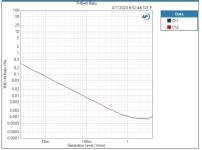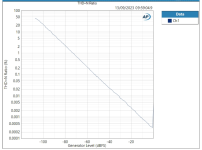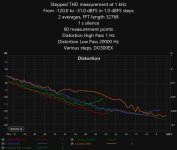Like pre distortion, anti harmonics of REW but done by hardware.
You can put the level. I guess the phase is always pi in their setup.
You can put the level. I guess the phase is always pi in their setup.
About part of what you said:I don't think I've ever seen a THD sweep in Amirs DAC measurements.
Just a thought, inspired by Ivans post in the other hump thread that got hijacked by the subjectivists: https://www.diyaudio.com/community/threads/return-of-the-ess-hump.391267/post-7205775
What if your DAC produces copious amounts of this hump and the AKM ADC is blind to this because of its aggressive noise shaping and the ES ADC detects it, maybe as aliasing? Using a switched attenuator would be one way, especially if it is extremely low distortoion as the scaler. The other idea would be to use a brick wall low pass or an inverted notch on the DAC output. Or a regular notch on the ADC which would filter out the fundamental. If the hump remains, it is not due to IMD in the ADC.
I will test with Ivan's APU the THD swept.
I don't think the AK5572 is blind to this hump. The THD+N graphs are more or less overlay exactly, it is only the THD that are different.
You know what is funny? Archimago with Cosmos seems to measure much more of an IMD hump than Amir with the AP. Here's the DO100:
https://blogger.googleusercontent.com/img/b/R29vZ2xl/AVvXsEiRM2LxSWB72X-GmRIMBYL9rW0ksdAxtNCw_vswQ2cEhkBBwuVQ0lPOtvnQ_94LOt7vK09c2RDIl5ouamkXOSIyiRZxZsP8vlRFIxzANre1u1XB-XEab5UtHpkdHHfiUOwwwROBDgRMK49JRoyIsevZaGnU1ZBYuRMBDUrtqmMY1tSlONxxeLIL893J/w640-h180/SMSL DO100 - IMD, TD+N Level - L+R.png
https://www.audiosciencereview.com/...d-distortion-xlr-balanced-usb-dac-png.208138/
I realize Archimago does DIN 250/8 kHz and Amir probably does SMPTE 60/7 kHz (too lazy to look it up). Still, we're comparing prounounced to barely there humps.
PS: DO100 1 kHz sweep has about the same hump as Sabaj (-90 dB at -40 db FS), but why does Archimage give a much higher noise floor for the Sabaj?
https://blogger.googleusercontent.com/img/b/R29vZ2xl/AVvXsEgXkf3LS2yM6rcAHYJjBkWA7ATRxLqFMNxVsUMezEQyrCoHqxSvmjJOpfzBQQ-hTh7HMrPGf90lqfzQvBrJxNiKNumpPo93vwiiTqCl95ycOhrzk_X6Tj0B0XYx5YfBcXUpTp5FLeJLm3hBmmdAzfDTn7UEIANF1-lHO0r1vhcjyBYwfaYifTZj0NiO/w640-h354/SMSL DO100 - XLR 1kHz Level Step and Linearity - L+R.png
https://blogger.googleusercontent.com/img/b/R29vZ2xl/AVvXsEiRM2LxSWB72X-GmRIMBYL9rW0ksdAxtNCw_vswQ2cEhkBBwuVQ0lPOtvnQ_94LOt7vK09c2RDIl5ouamkXOSIyiRZxZsP8vlRFIxzANre1u1XB-XEab5UtHpkdHHfiUOwwwROBDgRMK49JRoyIsevZaGnU1ZBYuRMBDUrtqmMY1tSlONxxeLIL893J/w640-h180/SMSL DO100 - IMD, TD+N Level - L+R.png
https://www.audiosciencereview.com/...d-distortion-xlr-balanced-usb-dac-png.208138/
I realize Archimago does DIN 250/8 kHz and Amir probably does SMPTE 60/7 kHz (too lazy to look it up). Still, we're comparing prounounced to barely there humps.
PS: DO100 1 kHz sweep has about the same hump as Sabaj (-90 dB at -40 db FS), but why does Archimage give a much higher noise floor for the Sabaj?
https://blogger.googleusercontent.com/img/b/R29vZ2xl/AVvXsEgXkf3LS2yM6rcAHYJjBkWA7ATRxLqFMNxVsUMezEQyrCoHqxSvmjJOpfzBQQ-hTh7HMrPGf90lqfzQvBrJxNiKNumpPo93vwiiTqCl95ycOhrzk_X6Tj0B0XYx5YfBcXUpTp5FLeJLm3hBmmdAzfDTn7UEIANF1-lHO0r1vhcjyBYwfaYifTZj0NiO/w640-h354/SMSL DO100 - XLR 1kHz Level Step and Linearity - L+R.png
Last edited:
For Fs = 96 kHz, has anyone tried applying dither bandpassed between 24 kHz and 48 kHz? The bandwidth is broad enough so the dither would look noiselike, as opposed to a naive implementation of narrowband noise which tends to have quasi-periodic components.
As of REW - as John writes in his documentation, stepped sweeps are more precise than continuous sweeps (quite logical, as the FFT runs on a buffer with samples of steady parameters).
Well, they are both AKM DACs and the ADC was Audio Precision, so no hump to be expected. Amir didn't measure one either in the SU-1.Hello all,
Here are 2 measurements made with Cosmos ADC.
First is for EMU 0404 usb card.
View attachment 1279293
Second is for SMSL SU-1
View attachment 1279294
The X axe's are not scaled but i don't see any hump there.
Regards!
The ESS hump is always there but often masked in the noise of a THD+N or IMD+N measurement for any number of reasons.You know what is funny? Archimago with Cosmos seems to measure much more of an IMD hump than Amir with the AP. Here's the DO100:
To see it clearly, we have to look at how a single-tone low/medium frequency spectrum (say, @ 1kHz) develops with level. Even better yet, look at the time-domain distortion residual, preferably with strong synchronous averaging. At high frequencies the signal dithers itself so to say and the hump gets distributed and appears as noise. That's also true for multitones when the high frequencies are densely populated.
Therefore, it's best to use a low frequency single sine where the regular H2/H3 will also be lower than at higher frequencies. The key is to keep the output voltage's slew rate low enough so that the final DAC output which is 5- or 6-bit slowly moves through its discrete output level ranges, to excite the full modulation pattern vs "momentary DC" so to say. We also note the distortion structure changes with applied DC to the test tone, for the same reason, a cyclic change with increased DC, about one cycle per output LSB.
And better use an ADC without hump. AK5572/74 is almost perfect below -10..20dB FS. Very clean spectrum with only a little H2/H3.
Impressive! Have you written about your take on Victor's oszillator anywhere?So it seems DAC is the culprit. Or is it?
To verify I switched to a 1kHz oscillator (my take on Victor's). Here is 1kHz oscillator + AK5394.
View attachment 1126662
As expected spectrum is quite clean.
No, ADC was Cosmos ADC.Well, they are both AKM DACs and the ADC was Audio Precision, so no hump to be expected. Amir didn't measure one either in the SU-1.
Sorry I assumed because there was an AP logo in the graphs. How did you interface the Cosmos ADC to an AP?
Here is various steps options. The rules are like that:
If written Nihtila, it means AK5572 ADC, if Cosmos then ES9822Pro ADC.
If written APU, it mean 1k APU between DAC and ADC.
If written +31db gain, then a +31 low noise gain is between DAC and here Cosmos ADC - No APU.
In all cases, DAC is DO300EX (AK4499). Note that sensitivity between Nihtila and Cosmos are different
but the X-axes is always the generator level, so DAC output is comparable.
One can see: APU for Cosmos ADC reduces Hump however it is still inferior to AK5572 that represent now a HUMP
that we did not see without APU.
If written Nihtila, it means AK5572 ADC, if Cosmos then ES9822Pro ADC.
If written APU, it mean 1k APU between DAC and ADC.
If written +31db gain, then a +31 low noise gain is between DAC and here Cosmos ADC - No APU.
In all cases, DAC is DO300EX (AK4499). Note that sensitivity between Nihtila and Cosmos are different
but the X-axes is always the generator level, so DAC output is comparable.
One can see: APU for Cosmos ADC reduces Hump however it is still inferior to AK5572 that represent now a HUMP
that we did not see without APU.
Attachments
For the AK5572 with APU, maybe this is not a Hump but overloading, AK5572 can't reach near 0dbfs like the ES9822Pro
Let me see if I can follow:
- APU notches out the 1 kHz fundamental from the DAC, so we are left with whatever harmonics and other spuriae the DAC sends out and whatever the ADC generates in terms of artefacts when faced with a < - 60 dB input signal
- shouldn't this be -31 dB gain (= 31 dB attenuation?). If so, the increase between -41 and -31 of the light green curve (Cosmos -31) is simply the DAC getting near fs and producing more harmonics. This would mean that there is no real hump in the DAC output, but I am not sure how to square this observation/interpretation with the other graphs.
- red curve (Nihtila + APU) being 8 dB lower than blue (Nihtila w/o APU) up to -30 dB makes sense to me: the harmonics in the DAC signal are still there, but the fundamental is gone. Some ADCs have level dependent noise, and maybe this is what we are seeing. As for the hump beginning at -28 dB, I don't think the Nihtila is anywhere near fs since the fundamental is supressed by > 60 dB. So what is this? Easiest explanation is that there is a hump in the DAC, in direct contradiction of the Cosmos -31 dB measurement. It would be interesting to see Nihtila -31 dB!
- dark green (Cosmos + APU) vs organge (Cosmos): the difference is striking! I would guess that the hump originates in the ADC when presented with a strong and somewhat busy spectrum. Note that the residual hump at -27 dB occurs right where Nihtila + APU also has its hump, so this could well be in the DAC
- Cosmos + APU vs. Nihtila + APU: why is the Nihtila so much quieter all the way to -30 dB? And why does this melt away once the presumed DAC hump sets in? Handwaiving explanation: the Nihtila has signal dependent noise, the Cosmos not so much? One would need to see the noise level vs. signal to decide
No. It is just another layout of Victor's oscillator.Impressive! Have you written about your take on Victor's oszillator anywhere?
Hi capslock,
Ivan's APU is an active notch that attenuates fundamental by 30 db.
Then there is an amplification of 20db or 26db. I used the 26db.
So, in practice fundamental is attenuated only by 4db, not 60db ! That the reason I am still working near the full scale of the AK5572 and as we see, AKM is sensitive to this, more than ES9822PRO.
The notch is very sharp of about Q=50. So sharp you can just add 30db to the results without notch.
Nevertheless, I am using a compensation file such that computation will be transparent when notch is in the path.
This notch gives you extra reduction of the noise after compensation (as DAC noise is lower than the ADC noise). However, we are considering only THD so it is not relevant.
The 31db that you see is DAC to COSMOS with 31db gain inside.
I did this test to see if the location of the hump interval is changed. However, I can't go with generator so high as I am reaching cosmos full scale. So, we may just see the beginning of the hump.
The title above picture is little misleading with it's '31db' as this title fits only when I measured with the 31db amplifier. REW insert the relevant title for one specific measurement when overlay. However, all other parameters are correct, like bandwidth, step size.
The end step is 0dbfs for cosmos and -3db for Nihtila and less when there is 31db gain as written.
So, the news here is that with APU the hump of the cosmos for 1k sweep more or less disappear.
The bad news is that when we put APU for Nihtila it is also improved further.
What I said about hump in this case in my previous post seems to me mistake. It is just the AKM ADC comes near it's full scale. It is not a hump what with see (Nihtila + APU).
I think it is clear, AK5572 is a much better ADC for measuring 1khz distortion as long as you are about 6-10db below it's full scale.
Pitty it has so high noise shaping.
Ivan's APU is an active notch that attenuates fundamental by 30 db.
Then there is an amplification of 20db or 26db. I used the 26db.
So, in practice fundamental is attenuated only by 4db, not 60db ! That the reason I am still working near the full scale of the AK5572 and as we see, AKM is sensitive to this, more than ES9822PRO.
The notch is very sharp of about Q=50. So sharp you can just add 30db to the results without notch.
Nevertheless, I am using a compensation file such that computation will be transparent when notch is in the path.
This notch gives you extra reduction of the noise after compensation (as DAC noise is lower than the ADC noise). However, we are considering only THD so it is not relevant.
The 31db that you see is DAC to COSMOS with 31db gain inside.
I did this test to see if the location of the hump interval is changed. However, I can't go with generator so high as I am reaching cosmos full scale. So, we may just see the beginning of the hump.
The title above picture is little misleading with it's '31db' as this title fits only when I measured with the 31db amplifier. REW insert the relevant title for one specific measurement when overlay. However, all other parameters are correct, like bandwidth, step size.
The end step is 0dbfs for cosmos and -3db for Nihtila and less when there is 31db gain as written.
So, the news here is that with APU the hump of the cosmos for 1k sweep more or less disappear.
The bad news is that when we put APU for Nihtila it is also improved further.
What I said about hump in this case in my previous post seems to me mistake. It is just the AKM ADC comes near it's full scale. It is not a hump what with see (Nihtila + APU).
I think it is clear, AK5572 is a much better ADC for measuring 1khz distortion as long as you are about 6-10db below it's full scale.
Pitty it has so high noise shaping.
Thanks for explaining. Then my interpretation above does not hold water.
Another question: so for Cosmos +31, you simply did run the DAC sweep only up to -31 dB?
Another question: so for Cosmos +31, you simply did run the DAC sweep only up to -31 dB?
- Home
- Design & Build
- Equipment & Tools
- ESS hump strikes back


